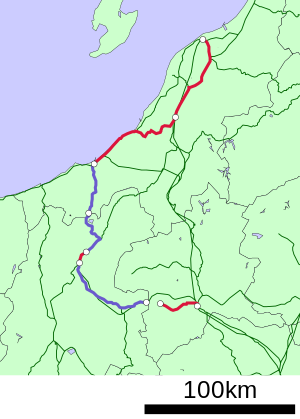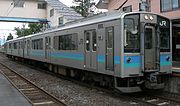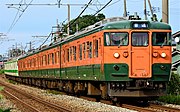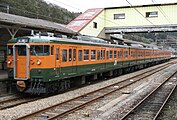|
Shin'etsu Main Line
The Shinetsu Main Line (Japanese: 信越本線, Hepburn: Shin'etsu-honsen) is a railway line, consisting of three geographically separated sections, operated by the East Japan Railway Company (JR East) in Japan. It was originally one continuous line connecting Takasaki and Niigata via Nagano. Since the opening and later extension of the Hokuriku Shinkansen, sections running in parallel have either been discontinued or transferred to third-sector railway companies. The name of the line refers to the old names for Nagano and Niigata prefectures, Shinano (Japanese: 信濃), and Echigo (Japanese: 越後). The discontinued section through the Usui Pass was famous for its steep 66.7‰ (6.67%) gradient.[1] SectionsFrom 14 March 2015, the line consists of the following three sections.
There are three small freight branches; from Echigo-Ishiyama Station to Niigata Freight Terminal, from Kami-Nuttari Junction to Nuttari Station (discontinued on 25 March 2010), and from Kami-Nuttari Junction to Higashi-Niigata-kō Station. ServicesTakasaki–Yokokawa
Shinonoi–NaganoAll trains run through on the Shinonoi Line or the Shinano Railway Line. Naoetsu–Niigata
As of 3 May 2023[update], the following services are operated.[2][3]
StationsTakasaki–YokokawaAll stations are in Gunma Prefecture.
Yokokawa–ShinonoiThe section between Yokokawa and Karuizawa was closed and the section between Karuizawa and Shinonoi was transferred to the ownership of the third-sector railway operator Shinano Railway from 1 October 1997 with the opening of the Hokuriku Shinkansen (Nagano Shinkansen) between Takasaki and Nagano. Shinonoi–NaganoAll stations are in Nagano, Nagano Prefecture.
Nagano–NaoetsuThe section between Nagano and Naoetsu was transferred to the ownership of the third-sector railway operators Shinano Railway and Echigo Tokimeki Railway from 14 March 2015 with the opening of the Hokuriku Shinkansen extension north of Nagano. Naoetsu–NiigataAll stations are in Niigata Prefecture.
Rolling StockPresentTakasaki–Yokokawa
Shinonoi–Nagano
Naoetsu–Niigata
FormerTakasaki–Yokokawa
Naoetsu–Niigata
History The Japanese Government Railways opened the Takasaki to Yokokawa section in 1885, the Naoetsu to Sekiyama section the following year, and the Sekiyama–Nagano–Karuizawa section in 1888. In order to surmount the 552 metre altitude difference between Yokokawa and Karuizawa (which are 10 km (6.2 mi) apart), it then constructed an Abt rack section through the Usui Pass, which opened in 1893, and was double-tracked for 1 km (0.62 mi) from Karuizawa to the top of the rack section. A horse-drawn tramway operated between Yokokawa and Karuizawa until the rack section opened.  The Hokuetsu Railway opened the Naoetsu to Nagaoka section in 1897, extending the line to Niigata in 1904. That company was nationalised in 1907. In 1909, the Imperial Japanese Railway authorities invited bids for the electrification of the route. A German company was selected to provide the engines and General Electric supplied the turbines at the power station. In 1912, the rack section was electrified using third rail at 600 V DC, this being the first use of this method in Japan. The electrification allowed for the use of faster and longer trains which reduced journey times and also pollution from the steam engines.[4] A link to archival footage of the rack section operation is available here Double-trackingThe Karuizawa to Nagano section was double-tracked between 1917 and 1920, with the Nagaoka to Miyauchi section double-tracked in 1931, and the Niitsu–Kamo section in 1944. Double-tracking of the remainder of the Niigata to Naoetsu line was undertaken in sections between 1958 and 1973. Double-tracking of the remainder of the Takasaki to Kaminagano line was undertaken in sections between 1963 and 1973, commencing with the replacement of the rack mechanism with an adhesion only electrified (1,500 V DC catenary) operation on the 1 in 15 (6.7%) grade. The rack equipment was initially kept as a contingency, and removed two months after the adhesion-only operation commenced and had proved its reliability. The Kurohime to Myoko-Kogen section was double-tracked in conjunction with a realignment in 1980. The Mure to Kurohime section was also realigned and prepared for double-tracking (including new double-track size tunnels), but the second track was not laid. ElectrificationThe Miyauchi to Nagaoka section was electrified in 1947 at 1,500 V DC in conjunction with the electrification of the Joetsu Line, with the Nagaoka to Niigata section electrified in 1962, the same year the Takasaki to Yokokawa section was commissioned to facilitate the extension to Nagano the following year via the new adhesion line through the Usui Pass mentioned above. The Nagano to Naoetsu section was electrified in 1966, and extended to Miyauchi in 1969. Separation into sectionsIn 1997, following the opening of the Nagano Shinkansen, the Yokokawa to Karuizawa section was closed, and the Karuizawa to Shinonoi section transferred to the third-sector Shinano Railway. On 14 March 2015, following the extension of the Hokuriku Shinkansen to Kanazawa, the Nagano to Naoetsu section was also spun off to the following two third-sector operating companies owned primarily by the respective prefectures and municipalities.[5]
Former connecting lines 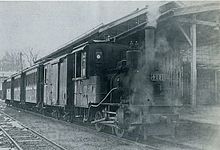 (Note - for the connections at stations between Karuizawa and Shinonoi, see Shinano Railway Line)
References
External links
|
|||||||||||||||||||||||||||||||||||||||||||||||||||||||||||||||||||||||||||||||||||||||||||||||||||||||||||||||||||||||||||||||||||||||||||||||||||||||||||||||||||||||||||||||||||||||||||||||||||||||||||||||||||||||||||||||||||||||||||||||||||||||||||||||||||||||||||||||||||||||||||||||||||||||||||||||||||||||||||||||||||||||||||||||||||||||||||||||||||||||||||||||||||||||||||||||||||||||||||||||||||||||||||||||||||||||||||||||||||||||||||||||||||||||||||||||||||||||||||||||||||||||||||||||||||||||||||||||||||||||||||||||||||||||||||||||||||||||||||||||||||||||||||||||||||||||||||||||||||||||||||||||||||||||||||||||||||||||||||||||||||||||||||||||||||||||||||||||||||||||||||||||||||||||||||||||||||||||||||||||||||||||||||||||||||||||||||||||||||||||||||||||||||||||||||||||||||||||||||||||||||||||||||||||||||||||||||||||||||||||||||||||||||||||||||||||||||||||||||||||||||||||||||||||||||||||||||||||||||||||||||||||||||||||||||||||||||||||||||||||||||||||||||||||||||||||||||||||||||||||

